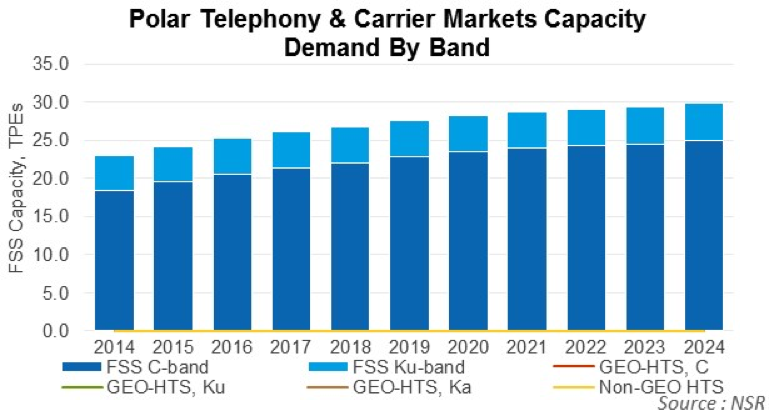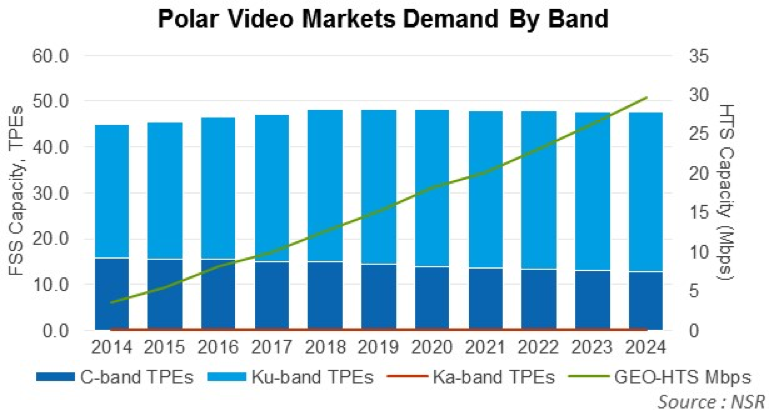Polar Markets are Calling
Feb 9th, 2016 by
Alan Crisp, NSR
One head-turner relating to Polar markets were
comments by LeoSat in 2015 about their Polar aspirations, a
business plan analyzed by NSR in our previous Polar bottom
line post. However one of the more interesting discoveries of
the Polar Regions is the significant Polar FSS demand
coming from Legacy Telephony & Carrier applications
and the Video markets.
NSR’s newly released report, Polar Satellite Markets, shows that
out of ~80 transponders of combined FSS C- and Ku-band Polar demand,
23% is used solely for Legacy Telephony & Carrier
applications, a share which is projected to increase to 34% by 2024.
80% of this capacity demand comes from Canada, Alaska and Russia
combined, with the rest coming from islands in the north Atlantic
Ocean (Iceland) and the Nordics. Interestingly, this growth in Polar
bucks a global trend of downward demand for Legacy Telephony &
Carrier, as noted in NSR’s Global Satellite Capacity Supply & Demand
report, which states that Legacy Telephony & Carrier will decrease
from 460 TPEs globally in 2014 to 280 TPEs in 2024 on C-band, with
similar declines on Ku-band.

Outside the Arctic, Telephony & Carrier carriage is shifting to
fiber based communications, or in some cases microwave or other
terrestrially based technologies. Likewise, communications are
shifting to IP-based links due to cost considerations and consumer
trends migrating to OTT voice standards.
However in the Polar Regions, due to extreme remoteness and
inhospitable climates, fiber rollout remains challenging. With
limited governmental budgets moving forward, and in many cases
“short term” thinking, fiber penetration isn’t expected to improve
much over the short to medium term. It is also unlikely that
governments in the north will ‘pull the plug’ on these populations,
and due to the unpopularity of such a move should it take place, the
logical ‘Band-Aid’ solution will continue to be utilizing satellite
capacity for connectivity in remote areas in Canada, Russia,
Scandinavia and islands in the Arctic. While the Polar Regions may
appear sparsely populated, there remain at least 10 cities
with populations over 30,000, the largest being Murmansk
and Noril’sk in Russia, which have populations over 100,000 each.
These cities will continue to drive satellite capacity for their
telephony requirements long-term, with no changes expected, over the
foreseeable future.
While other applications will feel the impact of GEO-HTS and
LEO-HTS capacity pushing down demand for legacy FSS capacity, Legacy
& Telephony will hold onto, and grow satellite demand in the Polar
Regions. Percentage share will grow too as other applications in
general shrink their demand requirements on FSS capacity as more and
more demand shifts to HTS based solutions. The main other
holdout is Video, which also encounters strong demand in
the Arctic.

However, all demand seen in the Polar Regions is
effectively spillover demand from Russia, Canada, and
Scandinavia. DTH platforms such as Tricolor primarily target
populations at lower latitudes, but beams do cover areas of the
Earth—and populations, however sparse—which are beyond 65 degrees
North. Due to the fact that low look angles cause issues, larger
satellite equipment is required to receive video broadcast signals
in these regions. And while broadband access remains fairly costly
in these regions, the price of DTH services remains at a much more
reasonable level and will continue to enjoy strong demand longer
term, especially with new UltraHD services around the corner. While
video demand will remain essentially of the legacy FSS type, there
is expected to to be some limited demand for satellite contribution
and occasional use television over GEO-HTS, such as through
Telenor’s Thor-7 in Northern Europe, and on ViaSat-2 after launch.
Bottom Line
While LEO-HTS services will impact the Polar market significantly
across some applications (most notably broadband access and VSAT
mobility), there remains a strong legacy FSS market across other
applications – most notably Legacy Telephony & Carrier and the Video
markets. These two applications are responsible for keeping fill
rates relatively high in the Arctic, with limited additional
capacity becoming available from decreasing demand from other
applications. Overall, FSS C-band and Ku-band are expected
to remain a stable, but a niche market in the Polar Regions
long-term.
However, there is the prospect of a game change where LEO-HTS
with 100% Polar coverage could offer solutions bundling telephony,
broadband access and video, running on an all-IP platform in the
form of VoIP, high-speed Internet access and OTT, which could
diminish, if not remove, the value proposition of FSS for Legacy
Telephony and Linear TV. At the writing of NSR’s polar study,
however, prospects for LEO-HTS are still highly speculative and the
Arctic may be seen more as opportunistic rather than core for
revenue generation.